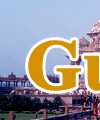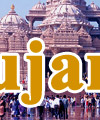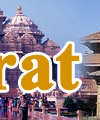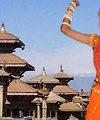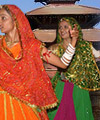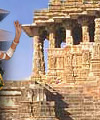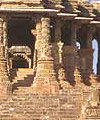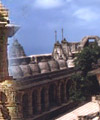|
Patan
Excursions > Around
Patan
[ Darbar Squqre | Mahabouddha
| Rani Ki Vav | Sahastralinga Talav
| The Ashokan Stupas | Mahavir Swami
Derasar | Machchhendranath Temple | Krishna
Temple ]
Darbar
Squqre
Patan Durbar Square, situated in the heart of the city, is the main
tourist attraction. The square is full of ancient palaces, temples,
and shrines noted for their exquisite carvings. One can rummage
for treasures and souvenirs in the various shops around the square.
The main attraction of Patan Durbar Square is the ancient Royal
Palace itself. It consists of three main chowks, or courtyards:
the central Mul Chowk, Sundari Chowk and Main Keshab Narayan Chowk.
In the northeastern corner of the courtyard is a triple-roofed octagonal
tower and Teleju Bhawani Temple, built by King Shree Niwas Malla
in 1667. Between the central Mul Chowk and Main Keshab Narayan Chowk,
there is the temple of Degu Taleju.
Top
Mahabouddha
A little further from Patan Durbar Square lies this Buddhist temple
made of clay bricks in which thousands of images of the Lord Buddha
are engraved. The Terra-cotta structure is a fourteenth-century Nepalese
architectural masterpiece. It was constructed by an architect named
Avay Raj.
Top
Rani
Ki Vav
Rani Ki Vav is an excellent example of subterranean architecture
of Gujarat. This Vav was constructed by Udaymati, the queen of Bhimdev
(1022-63 AD). The exquisitely carved sidewalls, pillars, beams,
series of steps and platforms lead to the elaborately carved water
well. Finely chiseled sculptures of maidens and Hindu deities, religious
motifs and geometrical patterns beautify every corner. Rani Ki Vav
represents the finest of the Indian sculptures and architecture.
Top
Sahastralinga
Talav
Sahastralinga Talav is among the many artificial tanks built in
different parts of Gujarat under the patronages of Siddhraj Jaisinh
(1093-1143 AD). The architecture of this tank integrated the great
sense of water management and sanctity of water in Hindu religion.
The tank used to receive water from a canal of the Saraswati River.
It had spread of about 5km with masonry embankments. There were
thousand Shiva Shrines on the edge of the tank.
Some remains of the same are even visible today. Looking at the
ruins, one can imagine the grandeur of this great water tank. The
famous legend of Siddhraj Jaisinh's desire for Jasma Odan, a beautiful
woman of the tank digger community, revolves around this tank. She
refused to marry him and committed sati to protect her honour.
Top
The
Ashokan Stupas
There are four ancient stupas, popularly believed to have been built
in 250 B. C. by Emperor Ashoka, at the Four Corners of Patan. The
four stupas are located in Pulchowk, Lagankhel, Ebahi (way to Shankhamul),
and in Teat (way to Sano Gaon) respectively. These stupas give evidence
to the city's ancient religious importance.
Top
Mahavir Swami Derasar
There are at least 100 Jain Temples in Patan. The most important
temple one can visit is the Mahavir Swami Derasar in Dhandherwad
with exquisitely carved wooden dome.
For visitors interested in Jainism and Ideology, a visit to the
Hemchandracharya was great scholar and grammarian - the first one
to formulate the grammar of the Gujarati language.
Top
Machchhendranath
Temple
The temple of Machchhendranath is another centre of attraction in
Patan. The temple lies in the middle of a wide spacious quadrangle
just at the outer rim of the market place. A fine clay image of
Avalokiteshwar or red Machchhendranath is housed here for six months
every year after which it is taken round the city of Patan in a
colourful chariot festival beginning in April-May and lasting sometimes
for several months.
Top
Krishna
Temple
The temple of Lord Krishna holds a commanding position in Patan's
palace complex. Though its style is not wholly native, it is reckoned
one of the perfect specimens of the Nepalese temple-craft. The three-storied
stone temple continues to elicit high praise from lovers of art
and beauty. It was built by King Siddhi Narasingha Malla in the
sixteenth century A.D. Most of the important scenes from the Mahabharata
and Ramayana epics have been carved in bas-relief. The minute details
of this relief work clearly show the high level that the art of
stone carving had attained in the sixteenth century.
The important Hindu temples are Kalika Mata, Sindhwai Mata, Harihareshwar
Mahadev and Brahma Kund.
Top
Information on Tours & Travel excursion of Patan city of Gujarat
- India
|
